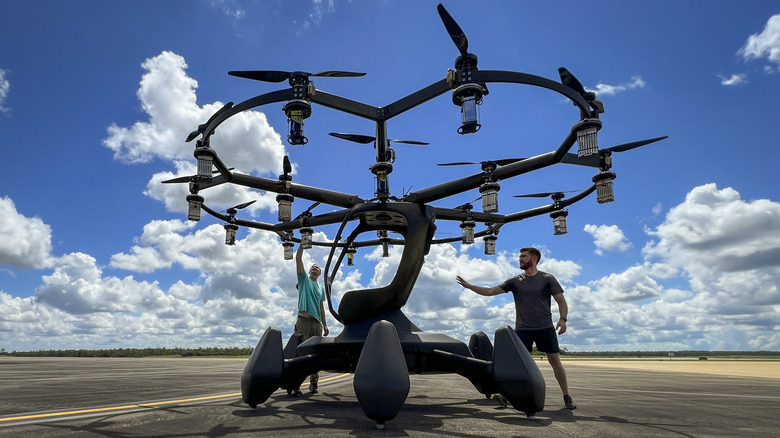Everything We Know About The Air Force's Futuristic New eVTOL
The world is currently in the beginnings of the third aviation revolution, where the field as a whole looks at moving from jet to electric propulsion. While the automotive industry is going all-in on electrification, one critical factor has so far prevented aviation from following: weight. As it stands, battery technology is nowhere near achieving pound-for-pound energy densities that could compete with jet fuels, and since weight is the last thing you want when making things fly, electric aircraft have been slow to get off the ground.
However, as with all other fossil-fuel-reliant industries, aviation will at some point or the other have to turn to electricity as its main power source, and this is where the U.S. Air Force comes in, with its twofold interest in the aviation industry — aircraft are the USAF's bread and butter, so it has a natural incentive to stay on top of all developments in the industry, but it also acts as an accelerator via programs such as AFWERX.
As such, while the Air Force is currently exploring and supporting the development of a variety of electric aircraft, including Electric Short Takeoff and Landing (eSTOL) aircraft, Electric Vertical Takeoff and Landing (eVTOL) aircraft present unique capabilities and opportunities. While the AFWERX Agility Prime program has been working with a host of companies in the development of eVTOL aircraft, one vehicle has stood out from the rest: Hexa.
Meet the Hexa eVTOL
Hexa is a single-seat eVTOL built by Lift Aircraft, a company based in Austin, Texas. With no doors, four to six legs depending on configuration and 18 propeller assemblies arranged within a hexagonal frame above the seat, the aircraft's design is heavily reminiscent of modern-day professional drone technology. In the same vein, the entire aircraft weighs only 432 pounds, thanks to its 100% carbon fiber airframe.
The cockpit layout of the Hexa is simple, with a central screen and single joystick to the pilot's right, connected to a triple-redundant flight computer, allowing it to be used by a single pilot without the requirement of a pilot's license. As far as safety is concerned, Hexa relies on two main features: redundant design and a ballistic parachute. Each of the 18 propeller assemblies has its own propeller, motor, and battery pack, allowing the Hexa to be operated even if up to six assemblies are rendered unusable. In the event of a catastrophic failure, the secondary failsafe is a ballistic parachute, ensuring the pilot is spared from too rough a landing.
Furthermore, the four-legged version of Hexa was designed to be amphibious — with four perimeter floats and one central float, allowing it to land on either land or water if necessary.
Why the USAF is investing in Hexa
Hexa's consumer-focused simplicity offers the military a unique benefit — any service member can pilot one in person or remotely with a few hours of training, providing the military with extraordinary mobility. In the Air Force's November 2022 testing, Hexa was piloted remotely by teams of two, with one person dedicated to piloting the aircraft and the other dedicated to monitoring its systems and surrounding conditions.
Beyond its versatility, small footprint, and operational simplicity, Hexa is also relatively easy to transport, with a March 2021 test finding that the disassembled eVTOL could likely be loaded into a C-130 heavy lift aircraft in as little as 15 minutes, with as many as five or six being transported at a time.
This fits into the overall goals of the AFWERX Agility Prime program, which helps fund the development of eVTOL platforms such as Hexa with the goal of ensuring the U.S. gets first access to its technology. While AFWERX is targeting the deployment of eVTOL tech for over 60 use cases in general, Avionics International reported that the Air Force was looking at use cases such as the remote extraction of service members and the delivery of critical equipment or resources without endangering lives.
To this end, having participated in the development of the technology and received training during the development process would ensure that the Air Force would be the first to deploy Hexa, and would also be its most effective user.
Hexa is not just for the USAF
The benefits of a small eVTOL vehicle aren't exclusive to the military — they present an excellent opportunity for the commercial and personal sectors as well, which are Lift Aircraft's primary target markets. After all, owning a personal aircraft that fits in your garage, doesn't need a runway, and can land more or less anywhere would be convenient for anybody. What's more, Hexa is designed to only be subject to regulations governing ultralight aircraft, which don't require a license to fly.
At the end of the day, Lift Aircraft, which manufactures Hexa, is a commercial operation first and a defense contractor second. While it is working with the USAF under the Agility Prime program, development for its deployment for personal and commercial use continues. In fact, many civilians, including Anderson Cooper, have had the privilege of flying in a Hexa ahead of U.S. airmen, who have only piloted the vehicle remotely.
That being said, you might have to hold off on making plans to take off from your driveway and commute via Hexa. Possible regulatory limitations aside, Lift is only set to start deliveries of a very limited number of Hexa aircraft to private buyers in April 2023 and has yet to announce plans for future deliveries, so your next best bet will likely be to keep up with their plans to deploy Hexa for recreational use in New York City, which could happen as early as the end of 2023.
